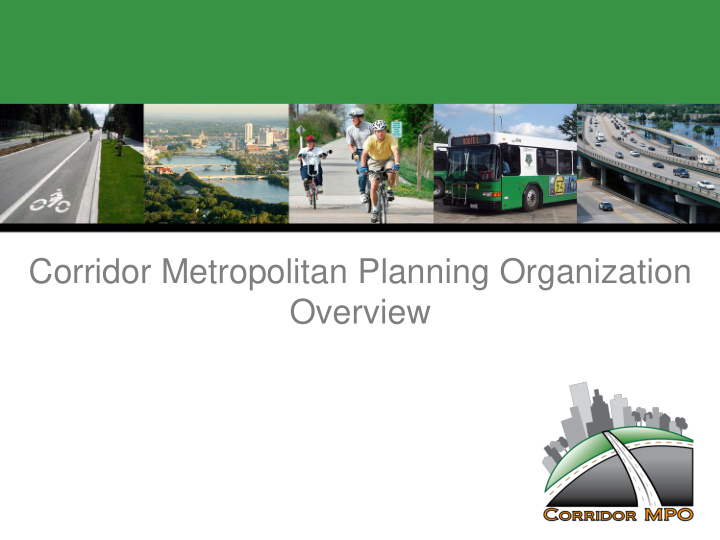



Corridor Metropolitan Planning Organization Overview
What is a Metropolitan Planning Organization (MPO)? • A Federally required entity • A representative group of local stakeholders • Leader of the transportation planning process for the metropolitan area • T he region’s policymaking organization responsible for prioritizing transportation initiatives
Who is the Corridor MPO? • The Corridor MPO is a partnership of metro area governments that strive to make a safe and efficient transportation network through smart transportation planning and civic engagement with the goal of attracting and retaining people and businesses in order to create a better community.
Corridor MPO Membership • Monica Vernon – Cedar Rapids • Mayor Snooks Bouska – Marion • Mayor Ron Corbett – Cedar • Tim Mooney – Marion Rapids • John Bender – Marion • Don Karr – Cedar Rapids • Cody Crawford – Marion • John Schnipkoweit – Cedar • Supervisor Lu Barron – Linn Rapids County • Samantha Dahlby – Cedar • Supervisor Ben Rogers – Linn Rapids County • Bill Bogert – Cedar Rapids • Mayor Tom Theis – Hiawatha • Ann Poe – Cedar Rapids • Mayor Ian Cullis – Robins • Jeff Pomeranz – Cedar Rapids • Mayor Jim Doyle – Ely • Pat Ball – Cedar Rapids • Mayor Jason Rabe – Fairfax • Julie Sina – Cedar Rapids • TBD – Cedar Rapids • Dave Elgin – Cedar Rapids • TBD – Cedar Rapids
Corridor MPO Planning Area
Corridor MPO Facts • Governed by a 23-member Policy Board comprised of Linn County Supervisors, Mayors, and citizen reps from – Cedar Rapids, Marion, Hiawatha, Robins, Ely, & Fairfax • Officially established in 1964 • Planning area of 326 square miles or 45% of Linn County, includes 90% of the County’s population
Corridor MPO Facts • Responsible for the development of regional plans and the annual distribution of $4 million dollars in federal funds to local transportation projects • Meetings are held on the 3 rd Thursday of the month at 1:30 pm • Staffed by Cedar Rapids’ Community Development Department
Examples of Corridor MPO Responsibilities • Generally, the preparation of transportation- related plans • “Transportation - related” can be expanded to include land use, preservation, the environment, and other topics of metro area interest • Transportation includes all modes – Walking, bike, automobile, & transit
Why is Transportation Planning Important? • Environment • Economy • Land use • Safety & health • Mobility & accessibility • Social equity • Communities & neighborhoods
How does the Corridor MPO impact Citizens? • The Corridor MPO estimates the metro population will have an increase of 95,000 people by the year 2040 or 45% growth. • All of these people will need homes, employment, schools, and retail and recreational opportunities. • What will make all of this possible? A Comprehensive Transportation System
How does the Corridor MPO impact Citizens? • In order to attract and retain citizens, a transportation system that provides choices in navigating the metro area in a safe and efficient manner will be essential. • A transportation system must provide citizens choices in getting to work, shopping, or play such as: • Taking public transit (i.e. buses), • Riding a bicycle, • Driving an automobile, • Or simply walking on sidewalks and trails.
How does the Corridor MPO impact Citizens? • Seeks to provide a transportation system that allows for mobility options for all citizens • The type and location of roads in that transportation system has a direct impact on how land develops and how people access that land.
Long-Range Transportation Plan • Includes all modes of transportation • Requires the cost of projects to be taken into consideration when making the plan – The plan can’t be “pie in the sky.” • Makes us think about the future, but is updated every 5 years so changing conditions can be considered • Connections 2040
Connections 2040 Key Points • Recommends Complete Streets • Recommends roadway standards • Recommends a Land Use Vision Plan • Roadway Vision Plan - $690 million • Trail Vision Plan - $91 million • Fiscally Constrained Plan – Roadway Plan - $173 million – Trails Plan - $35 million • Recommends mode split for MPO funding
Funding for Trails • The Corridor MPO believes a comprehensive trail system includes not only separated trails but on- street facilities such as bike lanes or sharrows. • On April 19, 2012, the Corridor MPO decided to dedicate 80% of its federal funding over the next five years towards trail and trail component projects. • Recently funded projects ($4,487,437 for FY16) – CEMAR Trail from Cedar Lake Loop to CR city limits – CEMAR Trail from Marion city limits to Hwy. 100 – CEMAR Trail from Hwy. 100 to Legion Park – CEMAR Trail from Thomas Park to 7 th St. • $3.9 million in funding still available for FY16
Funding for Trails – Next Steps • Identify metro trail system. • Identify street network that is ready for striping projects (bike lanes or sharrows).
Recommend
More recommend